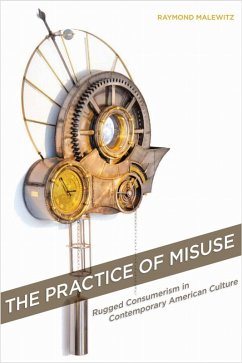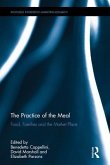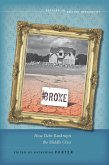- Gebundenes Buch
- Merkliste
- Auf die Merkliste
- Bewerten Bewerten
- Teilen
- Produkt teilen
- Produkterinnerung
- Produkterinnerung
In the age of Ikea Hackers and salvagepunks, this book charts the emergence of "rugged consumers" who creatively misuse, reuse, and repurpose the objects within their environments to suit their idiosyncratic needs and desires. Figures of both literary and material culture whose behavior evokes an American can-do ethic, rugged consumers mediate between older mythic models of self-sufficiency and the consumption-driven realities of our passive, post-industrial economy. Through their unorthodox encounters with the material world, rugged consumers show that using objects 'properly' is a…mehr
Andere Kunden interessierten sich auch für
![The Practice of the Meal The Practice of the Meal]() The Practice of the Meal206,99 €
The Practice of the Meal206,99 €![Proceedings of the Conference on Consumption and Saving, Volumes 1 and 2 Proceedings of the Conference on Consumption and Saving, Volumes 1 and 2]() Proceedings of the Conference on Consumption and Saving, Volumes 1 and 294,99 €
Proceedings of the Conference on Consumption and Saving, Volumes 1 and 294,99 €![The Objects of Affection The Objects of Affection]() Arthur A. BergerThe Objects of Affection38,99 €
Arthur A. BergerThe Objects of Affection38,99 €![Broke Broke]() Katherine PorterBroke117,99 €
Katherine PorterBroke117,99 €![Consumer Behavior: A Marketing Perspective Consumer Behavior: A Marketing Perspective]() Consumer Behavior: A Marketing Perspective136,99 €
Consumer Behavior: A Marketing Perspective136,99 €![Perceptions of the Association between Alcohol Misuse Perceptions of the Association between Alcohol Misuse]() Eugene G. MachimanaPerceptions of the Association between Alcohol Misuse36,99 €
Eugene G. MachimanaPerceptions of the Association between Alcohol Misuse36,99 €![Understanding Consumer Behavior Understanding Consumer Behavior]() Understanding Consumer Behavior128,99 €
Understanding Consumer Behavior128,99 €-
-
-
In the age of Ikea Hackers and salvagepunks, this book charts the emergence of "rugged consumers" who creatively misuse, reuse, and repurpose the objects within their environments to suit their idiosyncratic needs and desires. Figures of both literary and material culture whose behavior evokes an American can-do ethic, rugged consumers mediate between older mythic models of self-sufficiency and the consumption-driven realities of our passive, post-industrial economy. Through their unorthodox encounters with the material world, rugged consumers show that using objects 'properly' is a conventional behavior that must be renewed and reinforced rather than a naturalized process that persists untroubled through time and space. At the same time, this Utopian ideal is rarely met: most examples of rugged consumerism conceal rather than foreground the ideological problems to which they respond and thus support or ignore rather than challenge the structures of late capitalist consumerism. By analyzing convergences and divergences between subjective material practices and collectivist politics, Raymond Malewitz shows how rugged consumerism both recodes and reflects the dynamic social history of objects in the United States from the 1960s to the present.
Produktdetails
- Produktdetails
- Verlag: Stanford University Press
- Seitenzahl: 240
- Erscheinungstermin: 1. Oktober 2014
- Englisch
- Abmessung: 236mm x 161mm x 25mm
- Gewicht: 462g
- ISBN-13: 9780804791960
- ISBN-10: 0804791961
- Artikelnr.: 41120567
- Herstellerkennzeichnung
- Libri GmbH
- Europaallee 1
- 36244 Bad Hersfeld
- gpsr@libri.de
- Verlag: Stanford University Press
- Seitenzahl: 240
- Erscheinungstermin: 1. Oktober 2014
- Englisch
- Abmessung: 236mm x 161mm x 25mm
- Gewicht: 462g
- ISBN-13: 9780804791960
- ISBN-10: 0804791961
- Artikelnr.: 41120567
- Herstellerkennzeichnung
- Libri GmbH
- Europaallee 1
- 36244 Bad Hersfeld
- gpsr@libri.de
Raymond Malewitz is Assistant Professor of English at the School of Writing, Literature, and Film at Oregon State University.
Contents and Abstracts
The Practice of Misuse: Rugged Consumerism in Contemporary American Culture
Author(s): Raymond Malewitz
1Misuse: From Aesthetics to Practice
chapter abstract
This chapter provides a conceptual bridge between contemporary thing
theories, which champion the aesthetic products of the creative misuse of
objects, and new materialisms, which use the same activities as a means of
understanding and resisting the negative effects of consumerism under late
capitalism. The thing theories of Martin Heidegger, Bill Brown, and Ken
Alder maintain that the aesthetic "thing" comes into being when an object
breaks down and can no longer fulfill its standard function. Through an
extended reading of the failed Apollo 13 mission, the chapter shows how
this idea was redirected to critique what Evan Watkins calls the
"technoideological" culture of late capitalism. While a similar shift from
aesthetics to political practice informs twenty-first-century maker
communities and environmental activist groups, the chapter shows how the
practitioners of these activities often operate instead as champions of
late capitalism and clear manifestations of its dominant politics.
2Theaters of Rugged Consumerism
chapter abstract
This chapter shows how Utopian versions of American rugged consumerism
emerged from the material limitations of the nation's counterculture
theaters during the late sixties. In keeping with left-libertarian DIY
projects such as the Whole Earth Catalog and Adhocism, off-off-Broadway
playwrights such as Sam Shepard drew inspiration from their financial
limitations and wrote plays to accommodate the discarded objects that they
re-appropriated on walks around New York City. Drawing upon a number of
autobiographical accounts from off-off-Broadway playwrights collected in
the New York Public Library's theater archives as well as important
historical studies by Stephen Bottoms and David Crespy, the chapter show
how both within and beyond the magic circle of the stage,
off-off-Broadway's rugged consumers transformed commodities and their waste
products (including the commercial spaces of American theater) into renewed
sites of creative production.
3The Garden in the Machine
chapter abstract
This chapter positions Thomas Pynchon's encyclopedic novel Gravity's
Rainbow alongside recent models of human-object interactions such as
biomimetics, actor-network theory, and new vitalism. Pynchon's characters
view the social histories of two important objects in the novel-the V-2
rocket and celluloid plastic-as either linear or circular. In the case of
the former, objects are designed to maintain their structural integrity
over time, which completely separates producers and consumers and, for
Pynchon, catalyzes the environmental crisis of the late twentieth century.
In the case of the latter, commodities, like natural materials, operate in
a constant state of flux and thus have no singular use-value. This
ecological model of an object's social life destabilizes the
producer-consumer divide, reclaims the commodity as a site of creative
re-production, and partially ameliorates the environmental crisis unleashed
by industrial design procedures.
4The Rugged Consumer Bildungsroman
chapter abstract
This chapter examines the shift from left-leaning libertarian
countercultures of the 1960s and 1970s to the neoliberal libertarianism of
the 1980s and 1990s. The chapter begins by positing that accounts of Simon
Rodia's Watts Towers, like Franco Moretti's description of the prototypical
bildungsroman, proceed by a principle of ideological containment that
Moretti calls "the interiorization of contradiction" between an
individual's formless creativity and the conservative social constraints
that redirect this energy to serve normative ends. This same principle of
"interiorization" constitutes the central plot of Don DeLillo's Underworld
and Chuck Pahlaniuk's Fight Club; both novels' protagonists seem to rebel
against but ultimately reinforce the structural conditions that they
purport to combat. These bildungsroman plots thus testifies to the ways in
which the earlier countercultural possibilities of rugged consumerism
become integrated into the dominant institutions and formations of
late-century America.
5Ritual, Play, and Neoliberal Rugged Consumerism
chapter abstract
This chapter presents two historical perspectives on the neoliberal
restructuring of rugged consumerism in the 1980s. The chapter begins with a
discussion of the popular 1980s television show MacGyver. Debuting at the
start of Ronald Reagan's second presidential term, the program celebrates
the United States' neoliberal turn by championing the putative
self-reliance of private male citizens and by denigrating the work of
governmental agencies, non-Western militaries, and women through creative
acts of object repurposing. In contrast to this comic jingoism, Cormac
McCarthy's 2005 novel, No Country for Old Men, returns to the early 1980s
but frames its rugged consumerism as a matter of desperate survival rather
than a matter of choice. This novel and McCarthy's earlier historical
novels present a much gloomier vision of frontier mythology that
illustrates the devastating effects of free market individualism upon
American citizens.
6The Commodity at the End of the World
chapter abstract
This conclusion examines the relationship between post-apocalyptic art and
the economic and geopolitical crises of the late 20th and early 21st
century. The chapter begins by arguing that Midwestern American art
installations such at The Heidelberg Project and The City Museum show how
post-industrial discards can gain new life and forge new communities in
site-specific settings. It concludes by setting the rugged consumerism of
Margaret Atwood's Oryx and Crake and Cormac McCarthy's The Road within the
context of the Great Recession of 2007 and the post-9/11 War on Terror.
The Practice of Misuse: Rugged Consumerism in Contemporary American Culture
Author(s): Raymond Malewitz
1Misuse: From Aesthetics to Practice
chapter abstract
This chapter provides a conceptual bridge between contemporary thing
theories, which champion the aesthetic products of the creative misuse of
objects, and new materialisms, which use the same activities as a means of
understanding and resisting the negative effects of consumerism under late
capitalism. The thing theories of Martin Heidegger, Bill Brown, and Ken
Alder maintain that the aesthetic "thing" comes into being when an object
breaks down and can no longer fulfill its standard function. Through an
extended reading of the failed Apollo 13 mission, the chapter shows how
this idea was redirected to critique what Evan Watkins calls the
"technoideological" culture of late capitalism. While a similar shift from
aesthetics to political practice informs twenty-first-century maker
communities and environmental activist groups, the chapter shows how the
practitioners of these activities often operate instead as champions of
late capitalism and clear manifestations of its dominant politics.
2Theaters of Rugged Consumerism
chapter abstract
This chapter shows how Utopian versions of American rugged consumerism
emerged from the material limitations of the nation's counterculture
theaters during the late sixties. In keeping with left-libertarian DIY
projects such as the Whole Earth Catalog and Adhocism, off-off-Broadway
playwrights such as Sam Shepard drew inspiration from their financial
limitations and wrote plays to accommodate the discarded objects that they
re-appropriated on walks around New York City. Drawing upon a number of
autobiographical accounts from off-off-Broadway playwrights collected in
the New York Public Library's theater archives as well as important
historical studies by Stephen Bottoms and David Crespy, the chapter show
how both within and beyond the magic circle of the stage,
off-off-Broadway's rugged consumers transformed commodities and their waste
products (including the commercial spaces of American theater) into renewed
sites of creative production.
3The Garden in the Machine
chapter abstract
This chapter positions Thomas Pynchon's encyclopedic novel Gravity's
Rainbow alongside recent models of human-object interactions such as
biomimetics, actor-network theory, and new vitalism. Pynchon's characters
view the social histories of two important objects in the novel-the V-2
rocket and celluloid plastic-as either linear or circular. In the case of
the former, objects are designed to maintain their structural integrity
over time, which completely separates producers and consumers and, for
Pynchon, catalyzes the environmental crisis of the late twentieth century.
In the case of the latter, commodities, like natural materials, operate in
a constant state of flux and thus have no singular use-value. This
ecological model of an object's social life destabilizes the
producer-consumer divide, reclaims the commodity as a site of creative
re-production, and partially ameliorates the environmental crisis unleashed
by industrial design procedures.
4The Rugged Consumer Bildungsroman
chapter abstract
This chapter examines the shift from left-leaning libertarian
countercultures of the 1960s and 1970s to the neoliberal libertarianism of
the 1980s and 1990s. The chapter begins by positing that accounts of Simon
Rodia's Watts Towers, like Franco Moretti's description of the prototypical
bildungsroman, proceed by a principle of ideological containment that
Moretti calls "the interiorization of contradiction" between an
individual's formless creativity and the conservative social constraints
that redirect this energy to serve normative ends. This same principle of
"interiorization" constitutes the central plot of Don DeLillo's Underworld
and Chuck Pahlaniuk's Fight Club; both novels' protagonists seem to rebel
against but ultimately reinforce the structural conditions that they
purport to combat. These bildungsroman plots thus testifies to the ways in
which the earlier countercultural possibilities of rugged consumerism
become integrated into the dominant institutions and formations of
late-century America.
5Ritual, Play, and Neoliberal Rugged Consumerism
chapter abstract
This chapter presents two historical perspectives on the neoliberal
restructuring of rugged consumerism in the 1980s. The chapter begins with a
discussion of the popular 1980s television show MacGyver. Debuting at the
start of Ronald Reagan's second presidential term, the program celebrates
the United States' neoliberal turn by championing the putative
self-reliance of private male citizens and by denigrating the work of
governmental agencies, non-Western militaries, and women through creative
acts of object repurposing. In contrast to this comic jingoism, Cormac
McCarthy's 2005 novel, No Country for Old Men, returns to the early 1980s
but frames its rugged consumerism as a matter of desperate survival rather
than a matter of choice. This novel and McCarthy's earlier historical
novels present a much gloomier vision of frontier mythology that
illustrates the devastating effects of free market individualism upon
American citizens.
6The Commodity at the End of the World
chapter abstract
This conclusion examines the relationship between post-apocalyptic art and
the economic and geopolitical crises of the late 20th and early 21st
century. The chapter begins by arguing that Midwestern American art
installations such at The Heidelberg Project and The City Museum show how
post-industrial discards can gain new life and forge new communities in
site-specific settings. It concludes by setting the rugged consumerism of
Margaret Atwood's Oryx and Crake and Cormac McCarthy's The Road within the
context of the Great Recession of 2007 and the post-9/11 War on Terror.
Contents and Abstracts
The Practice of Misuse: Rugged Consumerism in Contemporary American Culture
Author(s): Raymond Malewitz
1Misuse: From Aesthetics to Practice
chapter abstract
This chapter provides a conceptual bridge between contemporary thing
theories, which champion the aesthetic products of the creative misuse of
objects, and new materialisms, which use the same activities as a means of
understanding and resisting the negative effects of consumerism under late
capitalism. The thing theories of Martin Heidegger, Bill Brown, and Ken
Alder maintain that the aesthetic "thing" comes into being when an object
breaks down and can no longer fulfill its standard function. Through an
extended reading of the failed Apollo 13 mission, the chapter shows how
this idea was redirected to critique what Evan Watkins calls the
"technoideological" culture of late capitalism. While a similar shift from
aesthetics to political practice informs twenty-first-century maker
communities and environmental activist groups, the chapter shows how the
practitioners of these activities often operate instead as champions of
late capitalism and clear manifestations of its dominant politics.
2Theaters of Rugged Consumerism
chapter abstract
This chapter shows how Utopian versions of American rugged consumerism
emerged from the material limitations of the nation's counterculture
theaters during the late sixties. In keeping with left-libertarian DIY
projects such as the Whole Earth Catalog and Adhocism, off-off-Broadway
playwrights such as Sam Shepard drew inspiration from their financial
limitations and wrote plays to accommodate the discarded objects that they
re-appropriated on walks around New York City. Drawing upon a number of
autobiographical accounts from off-off-Broadway playwrights collected in
the New York Public Library's theater archives as well as important
historical studies by Stephen Bottoms and David Crespy, the chapter show
how both within and beyond the magic circle of the stage,
off-off-Broadway's rugged consumers transformed commodities and their waste
products (including the commercial spaces of American theater) into renewed
sites of creative production.
3The Garden in the Machine
chapter abstract
This chapter positions Thomas Pynchon's encyclopedic novel Gravity's
Rainbow alongside recent models of human-object interactions such as
biomimetics, actor-network theory, and new vitalism. Pynchon's characters
view the social histories of two important objects in the novel-the V-2
rocket and celluloid plastic-as either linear or circular. In the case of
the former, objects are designed to maintain their structural integrity
over time, which completely separates producers and consumers and, for
Pynchon, catalyzes the environmental crisis of the late twentieth century.
In the case of the latter, commodities, like natural materials, operate in
a constant state of flux and thus have no singular use-value. This
ecological model of an object's social life destabilizes the
producer-consumer divide, reclaims the commodity as a site of creative
re-production, and partially ameliorates the environmental crisis unleashed
by industrial design procedures.
4The Rugged Consumer Bildungsroman
chapter abstract
This chapter examines the shift from left-leaning libertarian
countercultures of the 1960s and 1970s to the neoliberal libertarianism of
the 1980s and 1990s. The chapter begins by positing that accounts of Simon
Rodia's Watts Towers, like Franco Moretti's description of the prototypical
bildungsroman, proceed by a principle of ideological containment that
Moretti calls "the interiorization of contradiction" between an
individual's formless creativity and the conservative social constraints
that redirect this energy to serve normative ends. This same principle of
"interiorization" constitutes the central plot of Don DeLillo's Underworld
and Chuck Pahlaniuk's Fight Club; both novels' protagonists seem to rebel
against but ultimately reinforce the structural conditions that they
purport to combat. These bildungsroman plots thus testifies to the ways in
which the earlier countercultural possibilities of rugged consumerism
become integrated into the dominant institutions and formations of
late-century America.
5Ritual, Play, and Neoliberal Rugged Consumerism
chapter abstract
This chapter presents two historical perspectives on the neoliberal
restructuring of rugged consumerism in the 1980s. The chapter begins with a
discussion of the popular 1980s television show MacGyver. Debuting at the
start of Ronald Reagan's second presidential term, the program celebrates
the United States' neoliberal turn by championing the putative
self-reliance of private male citizens and by denigrating the work of
governmental agencies, non-Western militaries, and women through creative
acts of object repurposing. In contrast to this comic jingoism, Cormac
McCarthy's 2005 novel, No Country for Old Men, returns to the early 1980s
but frames its rugged consumerism as a matter of desperate survival rather
than a matter of choice. This novel and McCarthy's earlier historical
novels present a much gloomier vision of frontier mythology that
illustrates the devastating effects of free market individualism upon
American citizens.
6The Commodity at the End of the World
chapter abstract
This conclusion examines the relationship between post-apocalyptic art and
the economic and geopolitical crises of the late 20th and early 21st
century. The chapter begins by arguing that Midwestern American art
installations such at The Heidelberg Project and The City Museum show how
post-industrial discards can gain new life and forge new communities in
site-specific settings. It concludes by setting the rugged consumerism of
Margaret Atwood's Oryx and Crake and Cormac McCarthy's The Road within the
context of the Great Recession of 2007 and the post-9/11 War on Terror.
The Practice of Misuse: Rugged Consumerism in Contemporary American Culture
Author(s): Raymond Malewitz
1Misuse: From Aesthetics to Practice
chapter abstract
This chapter provides a conceptual bridge between contemporary thing
theories, which champion the aesthetic products of the creative misuse of
objects, and new materialisms, which use the same activities as a means of
understanding and resisting the negative effects of consumerism under late
capitalism. The thing theories of Martin Heidegger, Bill Brown, and Ken
Alder maintain that the aesthetic "thing" comes into being when an object
breaks down and can no longer fulfill its standard function. Through an
extended reading of the failed Apollo 13 mission, the chapter shows how
this idea was redirected to critique what Evan Watkins calls the
"technoideological" culture of late capitalism. While a similar shift from
aesthetics to political practice informs twenty-first-century maker
communities and environmental activist groups, the chapter shows how the
practitioners of these activities often operate instead as champions of
late capitalism and clear manifestations of its dominant politics.
2Theaters of Rugged Consumerism
chapter abstract
This chapter shows how Utopian versions of American rugged consumerism
emerged from the material limitations of the nation's counterculture
theaters during the late sixties. In keeping with left-libertarian DIY
projects such as the Whole Earth Catalog and Adhocism, off-off-Broadway
playwrights such as Sam Shepard drew inspiration from their financial
limitations and wrote plays to accommodate the discarded objects that they
re-appropriated on walks around New York City. Drawing upon a number of
autobiographical accounts from off-off-Broadway playwrights collected in
the New York Public Library's theater archives as well as important
historical studies by Stephen Bottoms and David Crespy, the chapter show
how both within and beyond the magic circle of the stage,
off-off-Broadway's rugged consumers transformed commodities and their waste
products (including the commercial spaces of American theater) into renewed
sites of creative production.
3The Garden in the Machine
chapter abstract
This chapter positions Thomas Pynchon's encyclopedic novel Gravity's
Rainbow alongside recent models of human-object interactions such as
biomimetics, actor-network theory, and new vitalism. Pynchon's characters
view the social histories of two important objects in the novel-the V-2
rocket and celluloid plastic-as either linear or circular. In the case of
the former, objects are designed to maintain their structural integrity
over time, which completely separates producers and consumers and, for
Pynchon, catalyzes the environmental crisis of the late twentieth century.
In the case of the latter, commodities, like natural materials, operate in
a constant state of flux and thus have no singular use-value. This
ecological model of an object's social life destabilizes the
producer-consumer divide, reclaims the commodity as a site of creative
re-production, and partially ameliorates the environmental crisis unleashed
by industrial design procedures.
4The Rugged Consumer Bildungsroman
chapter abstract
This chapter examines the shift from left-leaning libertarian
countercultures of the 1960s and 1970s to the neoliberal libertarianism of
the 1980s and 1990s. The chapter begins by positing that accounts of Simon
Rodia's Watts Towers, like Franco Moretti's description of the prototypical
bildungsroman, proceed by a principle of ideological containment that
Moretti calls "the interiorization of contradiction" between an
individual's formless creativity and the conservative social constraints
that redirect this energy to serve normative ends. This same principle of
"interiorization" constitutes the central plot of Don DeLillo's Underworld
and Chuck Pahlaniuk's Fight Club; both novels' protagonists seem to rebel
against but ultimately reinforce the structural conditions that they
purport to combat. These bildungsroman plots thus testifies to the ways in
which the earlier countercultural possibilities of rugged consumerism
become integrated into the dominant institutions and formations of
late-century America.
5Ritual, Play, and Neoliberal Rugged Consumerism
chapter abstract
This chapter presents two historical perspectives on the neoliberal
restructuring of rugged consumerism in the 1980s. The chapter begins with a
discussion of the popular 1980s television show MacGyver. Debuting at the
start of Ronald Reagan's second presidential term, the program celebrates
the United States' neoliberal turn by championing the putative
self-reliance of private male citizens and by denigrating the work of
governmental agencies, non-Western militaries, and women through creative
acts of object repurposing. In contrast to this comic jingoism, Cormac
McCarthy's 2005 novel, No Country for Old Men, returns to the early 1980s
but frames its rugged consumerism as a matter of desperate survival rather
than a matter of choice. This novel and McCarthy's earlier historical
novels present a much gloomier vision of frontier mythology that
illustrates the devastating effects of free market individualism upon
American citizens.
6The Commodity at the End of the World
chapter abstract
This conclusion examines the relationship between post-apocalyptic art and
the economic and geopolitical crises of the late 20th and early 21st
century. The chapter begins by arguing that Midwestern American art
installations such at The Heidelberg Project and The City Museum show how
post-industrial discards can gain new life and forge new communities in
site-specific settings. It concludes by setting the rugged consumerism of
Margaret Atwood's Oryx and Crake and Cormac McCarthy's The Road within the
context of the Great Recession of 2007 and the post-9/11 War on Terror.








